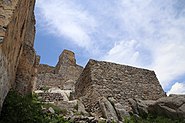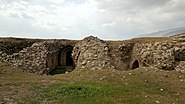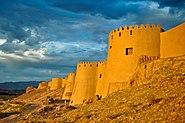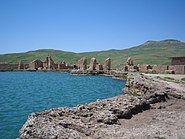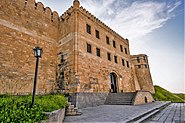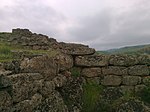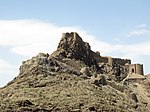Lambsar Castle
| Lambsar | |
|---|---|
لمبسر | |
 Lambsar Castle | |
| General information | |
| Type | Castle |
| Location | Alamut |
| Town or city | Razmian |
| Country | Iran |
| Coordinates | 36°32′51″N 50°13′38″E / 36.5476°N 50.2273°E |
| Part of a series on Islam Isma'ilism |
|---|
 |
|
|
Lambsar (
Only ruins remain of this magnificent fortress today. Very deep valleys surrounding the fortress make it impossible to access from the East and West sides. The North and South fronts are the only possible ways to get into the fortress. Although the slope of the mountain with a difference of 150m on both levels is stretched from north to south with a length of 480m, the castle is more than 190m in width. The huge two-layered parapets made up of very large 10m high stones, along with the main building in the north of the fortress with 1.2m wide cut stone walls, wonderful water reservoirs and grain stores in the south and southeast of the castle, towers and a water supply system are among the characteristics and features left within the Lambsar fortress which intrigue visitors. In the North side of the fortress a huge building with 4 smaller extensions remain which face to the East.
Final days
The Isma'ilis’ forts were the last line of defense against
Gallery
-
The castle measures 180m in width, with walls measuring 1.2 m in thickness at places.
-
Remains of Lambsar Castle
-
Around Lambsar Castle
-
Lambsar Castle, top view
See also
- Muhammad Tapar's anti-Nizari campaign
- Ismaili
- Iranian architecture
- Alamut Castle
- Atashgah Castle
- Masyaf Castle
External links
References
- ^ يوسف, فضايى، (2004). تحقيق در تاريخ و عقايد مذاهب اهل سنت اسماعيليه (in Persian). آشيانه كتاب،. p. 366.
- ^ "Castle of Lamasar". Institute of Ismaili Studies. Retrieved 11 February 2014.
- ^ Bretschneider, E. (1910). Mediæval Researches from Eastern Asiatic Sources: pt. 3. Explanation of a Mongol-Chinese mediæval map of central and western Asia. pt. 4 Chinese intercourse with the countries of central and western Asia during the fifteenth and sixteenth centuries. K. Paul, Trench, Trübner & Company, Limited. p. 110.








